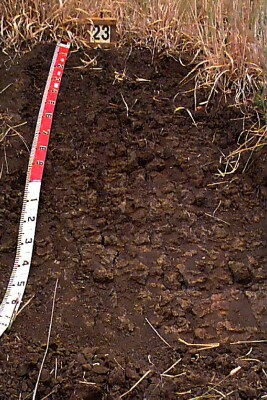LSWW23
| Site: LSWW23 | Land Unit: Dundas Trachyte |
| Aust. Soil Class.: Melanic, Black FERROSOL / DERMOSOL (confidence level 4). | |
| General Land Unit Description: There are a few isolated outcrops of Jurassic trachyte in the north-western portion of the study area, with the largest outcrop being north east of Coleraine. There are also some colluvial slopes on the edge of trachyte outcrops around the Dundas and Merino Tablelands. The trachyte hills often have rock outcrop and reasonably shallow soils on the crests and upper slopes. The main soil type on the upper slopes is a Brown Sodosol although Chromosols also occur and they are commonly sodic at depth. The soils on the colluvial slopes tend to be black cracking clays (Vertosols) or Black Vertic Sodosols. These soils are similar to the black soils of the dissected Merino Tablelands land unit. The soils on these slopes are a complex mix of different soil forming processes. This site is on the steeply dissected hills and rises leading to the Glenelg River and it’s tributaries. Trachyte is often found outcropping through the Tertiary sediments and in association with older sediments and granite. Due to the steep slopes the lower slopes often have an accumulation of colluvial material deposited on top. |
Site Description:
| Geology: Jurassic basalt | Landform pattern: Hill |
| Position in landscape: Lower slope | Internal drainage: Moderately well drained |
Soil Profile Morphology
| A1 | 0-10 cm | Very dark grey (2.5Y3/1) light clay; strong polyhedral structure, (peds 10-20 mm), breaking to strong blocky structure, (peds 5-10 mm), strong consistence when dry. pH 6.5. |  |
| Subsoil | |||
| B21 | 10-40 cm | Very dark grey (10YR3/1) light clay; strong polyhedral structure, (peds 10-20 mm), breaking to strong blocky structure (peds 5-10 mm), very strong consistence when dry. pH 6.9 | |
| B22 | 40-70 cm | Very dark grey (10YR3/1) heavy clay; strong angular blocky structure, (peds 20-50 mm), breaking to strong polyhedral structure, (peds 5-10 mm), very strong consistence when dry. pH 7.3. | |
| B23 | 70-120 cm | Light olive brown (2.5Y5/3) heavy clay; many dark grey and yellow brown mottles, structure and consistence similar to horizon above. pH 7.9. | |
| B24 | 120+ cm | Light olive brown (2.5Y5/3) heavy clay; many mottles, structure and consistence similar to above, a few ferruginised iron nodules. |
Key Profile Features
- Strong structure throughout
- Uniform clay soil
- Mottling in the deeper subsoil


